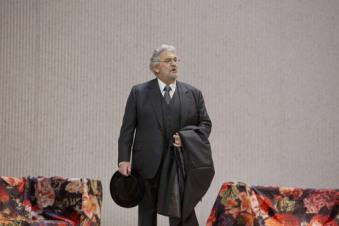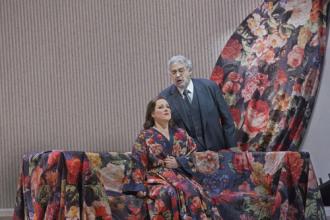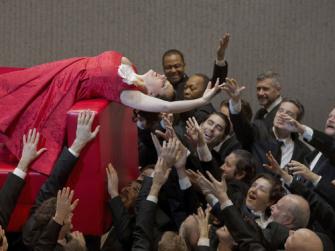Domingo Takes the Lead from Damrau

Placido Domingo as Germont (AP Photo/Ken Howard, Met Opera)
Continuing with my review of the Verdi bicentennial celebration at the Metropolitan Opera, the next broadcast work to be heard was La Traviata on March 30, in Willy Decker’s Salzburg-borrowed production from last year, which premiered at the Met with Russian soprano Marina Poplavskaya as Violetta Valery. For this revival, the German Diana Damrau took on the challenge of Violetta’s formidable vocal range, with Albanian tenor Saimir Pirgu as Alfredo Germont, and the famed Spanish tenor (now baritone) Placido Domingo as the elder Giorgio Germont.
For an opera based on Alexandre Dumas Fils’ play and novel, La Dame aux Camélias (“The Lady of the Camellias”) – one that’s primarily focused on the female lead and her transition from worldly courtesan to noble, self-sacrificing heroine – it’s a rare occurrence indeed to have that focus shift away from the soprano protagonist to the tenor, or is it the baritone?
Superstar overachiever Placido Domingo first sang the tenor part of Alfredo as far back as 1961 in Monterrey, Mexico, and most memorably at New York City Opera in Frank Corsaro’s landmark 1966 production with Patricia Brooks and Dominic Cossa. Domingo later took on the role at the Met and other international opera houses. But the part of Giorgio Germont has traditionally remained the property of the baritone.
A high-lying, lyrically expansive role, in the frame of Verdi’s other middle-period creations such as Rigoletto and the Count Di Luna from Il Trovatore, Germont has been coveted by singers for over a century and a half. Some of the finest interpreters in the business have undertaken this short but dramatically/vocally appealing character: from the Italians Mattia Battistini, Giuseppe De Luca, Riccardo Stracciari, Ettore Bastianini, Tito Gobbi, Rolando Panerai, Renato Bruson and Leo Nucci, to the Americans John Charles Thomas, Robert Weede, Richard Bonelli, Lawrence Tibbett, Leonard Warren, Robert Merrill, Sherrill Milnes, Cornell MacNeil and Thomas Hampson; along with the Germans Heinrich Schlusnuss, Josef Metternich and Dietrich Fischer-Dieskau, Frenchmen Michel Dens, Robert Massard, Ernest Blanc and Ludovic Tézier, Russians Pavel Lisitsian, Vladimir Chernov and Dmitri Hvorostovsky, and Brazilians Paulo Fortes and Lourival Braga, among many, many others.
I never expected to experience an artist from another vocal category to tackle this part, although I am familiar with the career paths taken by both Renato Zanelli and Ramón Vinay, two versatile Chilean singers who switched from baritone to tenor (and, in Vinay’s case, back to baritone again). However, since 2009 Señor Domingo, whose full name translates to “Placid Sunday” (and who began his professional career as a baritone in the late 1950s) and nearing the twilight of his performing days, has expanded into lower-voiced territory with his assumption of the title role in Verdi’s Simon Boccanegra, followed subsequently by the same composer’s Rigoletto in 2010 and 2011, Nabucco in 2012, and now Germont in 2013.
I can’t speak for Nabucco, which I have not heard, but of his Rigoletto and Simon Boccanegra there is much to admire in the earnestness of his endeavors. However, after listening closely to these varied assignments, I find the timbre of Domingo’s voice to be absolutely wrong for both these parts. Boccanegra especially demands an individual of weight and stature, with a sizable voice to match. Ditto for Germont, who represents the authority as well as the key morality figure in Traviata.

Damrau & Domingo in La Traviata (Ken Howard / Met Opera)
As a tenor, Domingo had authority to spare in such traversals as Otello, Manrico, Siegmund, even Parsifal. I’m afraid that, as a late-in-the-day baritone Germont, he is nowhere near what Verdi had imagined. Oh, yes, the tenderness and sensitivity are there, as is the all-important empathy for Violetta’s plight – a plight of Germont’s making, I should add. But the heft and strength, along with the “sound” and substance of a full-fledged lower-voiced singer were simply nowhere to be found. That fact that Placido easily attained the role’s highest notes, including some of the unwritten ones, was insufficient to justify the Met’s indulgence of this prized artist’s whims. Where’s the challenge in that, where’s the excitement of anticipation? There was none to be had, sad to say.
Please do not misunderstand my intentions, which are not to disparage a beloved singer, one whose career and artistry I have been fond of following with some interest since his 1966 appearance in Ginasetera’s Don Rodrigo at NYCO. He has brought much joy and comfort to these ears, as my previous post regarding his Don Alvaro in La Forza del Destino clearly noted.
But, as a Latin artist, one who has made his fellow Latinos justifiably proud of his many career accomplishments over the years, I can’t help feeling that Placido is coasting down an artistically barren path unworthy of our time and his efforts. I trust he will take this advice to heart: You are a fine musician and opera-house administrator, Placido, with survival in the opera world and longevity and good health on your side. Please give this foolishness up now, while your public is still behind you.

Diana Damrau as Violetta (Ken Howard / Met Opera)
As for the other singers on the broadcast, soprano Damrau gave one of the best portrayals of Violetta I have heard in a long, long time. Her sprightly vocal personality reminds me of the late Spanish soprano Pilar Lorengar, whose classic rendition of the part has been preserved for posterity on the Decca/London label. I was particularly taken with Damrau’s discretely timed pauses in between the repeated phrase of “Gioir!” during the first act “Sempre libera” (“Always free”), where she adroitly negotiated the rapid-fire coloratura with surprising ease and, most impressively, with a spectacular high note at the end. Her superb pairing with both Mr. Domingo and tenor Pirgu earned much praise from a very appreciative audience.
Her Alfredo, Mr. Pirgu, with a smallish though pleasant-sounding voice, still managed to convey the character’s youthful ardor and lovestruck nature to good effect (Domingo should be proud, I think, of this young artist), as well as his quicksilver temper. The voice hardened noticeably above the staff, though, but at least he gave the high C at the end of his cabaletta, “O mio rimorso,” the old college try – even though the result wasn’t exactly applause inducing.
This production, originally conceived to take place in one, long continuous act without interruption or intermission, was divided into two at the Met. By doing this, the momentum and build-up to Violetta’s tragic death are lost, as the Salzburg DVD/Blu-ray Disc edition of the opera so movingly proved. Decker’s single-set concept, with an ominous giant clock ticking away what little time Violetta has left to enjoy life, is concentrated around the soprano and tenor – a most innovative plot device, as is the use of two Dr. Grenvil’s, one of who doubles as the personification of death. Chilling!
Montreal-born conductor Yannick Nézet-Séguin held it all together in a most convincing manner, with a performance of subtlety, grace and overwhelming compassion. One thing I admired: he did not race through the proceedings at breakneck speed, as he had done a few years back with Bizet’s Carmen. No, this time out the maestro took his time to make his points count, and complemented the soloists throughout without the drive and thunder of a Toscanini. Instead, I sensed the inner workings of a young Carlo Maria Giulini at play in Yannick’s choice of tempos. As I said, a rare occurrence, indeed!
(To be continued)
Copyright © 2013 by Josmar F. Lopes

